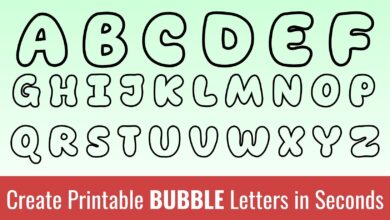Backwards 3: The Ultimate Guide to Understanding Its Significance

Introduction to the number 3 and its symbolism
Backwards 3 the number 3 holds a special place in the tapestry of our lives. It’s not just another numeral; it’s steeped in symbolism and meaning that stretches across cultures, history, and even mathematics. But have you ever seen it turned backwards? The backwards 3 invites curiosity and intrigue, challenging us to dig deeper into its significance. This unique shape represents more than just a flipped digit—it embodies a world of mystery waiting to be explored. Join us as we unravel the layers behind this captivating symbol, revealing its origins, cultural importance, mathematical relevance, everyday uses, and the controversies that surround it. Get ready to embrace the mystique of backwards 3!
The Origins of Backwards 3
The concept of the backwards 3, often seen as a simple number flipped, carries deeper roots. This symbol’s history can be traced back to ancient civilizations that used various forms of writing and numerology.
In some cultures, numbers were not just digits but held spiritual significance. The backwards 3 began appearing in different contexts, suggesting transformation or change. Its unique shape caught the attention of artists and thinkers alike.
Medieval manuscripts sometimes featured the backward form, representing concepts beyond mere mathematics. Scholars debated its meaning in relation to fate or destiny.
As time progressed, this peculiar numeral evolved into a visual shorthand for ideas like rebellion and innovation—challenging conventional norms with its flipping perspective. It embodies creativity born from subversion against traditional structures.
Cultural and Historical Significance of Backwards 3
Across various cultures, the backwards 3 holds intriguing meanings. In some traditions, it symbolizes transformation and change. The shape invites interpretations that transcend mere numerical significance.
Historically, artists and mystics have often used this symbol to convey deeper truths. It appears in ancient texts where its visual representation is linked to spiritual journeys and enlightenment.
In modern times, graffiti artists have adopted the backwards 3 as a form of rebellion against conventional norms. This playful twist on a simple number adds layers of meaning to street art.
Various religions also incorporate similar shapes into their iconography. Here, they signify concepts like unity or duality, emphasizing connections between different realms of existence.
From ancient civilizations to contemporary movements, the cultural resonance of the backwards 3 continues to evolve while retaining its enigmatic allure.
Mathematical Importance of Backwards 3
The backwards 3, often seen in mathematical contexts, offers a unique perspective on numbers. Its shape resembles the letter “E,” which can symbolize various concepts depending on context.
In certain mathematical disciplines, this form may represent functions or transformations. For instance, it’s sometimes used to denote specific operations in advanced equations. While not commonly featured in basic arithmetic, its significance grows with complexity.
Moreover, the stylized version of 3 plays a role in visual representations of data. Graphs and charts might incorporate it for clarity or emphasis when illustrating trends.
Beyond traditional mathematics, artists and designers find inspiration from its aesthetic appeal. This blend of art and math highlights how numbers can transcend mere calculations to become symbols rich with meaning.
Using Backwards 3 in Everyday Life and Art
The backwards 3 has found its way into various aspects of everyday life and art. You might see it in graffiti, where artists use the shape to create dynamic and thought-provoking pieces. Its unique form invites viewers to pause and reconsider their interpretation.
In design, the backwards 3 adds a touch of whimsy or an avant-garde flair. Brands sometimes incorporate this symbol into logos or marketing materials to stand out from the crowd.
Even in typography, designers play with variations of letters and numbers for visual impact. The backwards 3 can evoke curiosity, making it memorable among consumers.
Writers have also embraced this numeral as a metaphor for looking at things from a different perspective. It serves as a reminder that not everything is straightforward; sometimes, we must turn our viewpoints around to grasp deeper meanings hidden beneath the surface.
Controversies Surrounding Backwards 3
The backwards 3 has sparked a range of debates across various fields. Some argue it’s merely a stylistic choice, while others believe it holds deeper meanings in culture and art.
Critics often see its use as unorthodox. They question whether adopting such symbols dilutes traditional numerology or introduces confusion. This leads to discussions about authenticity and representation.
In the realm of education, some educators worry that using unique symbols can hinder learning. The debate centers on clarity versus creativity—how much should we embrace unconventional expressions?
Social media plays a role too. Memes featuring the backwards 3 have gone viral, but not without backlash from purists who feel this trivializes its significance.
Artistic interpretations vary widely, leading to disagreements among artists themselves about its meaning and purpose. Each perspective adds layers to the ongoing conversation surrounding this intriguing symbol.
Conclusion: Embracing the Mystique of Backwards 3
The allure of the backwards 3 is undeniable. This simple yet intriguing symbol captures attention across various fields, from art to mathematics. It invites curiosity and sparks conversations about its meaning in our lives.
As we have explored, this number transcends mere digits. Its origins tell a story that intertwines with culture and history, showcasing its significance throughout time. The mathematical implications are fascinating too, adding depth to its appeal.
In everyday life, the backwards 3 serves as a reminder of creativity and perspective shifts. Whether it’s found in design or personal expression, it encourages us to think outside conventional boundaries.
Controversies add another layer to the mystique surrounding this character. Different interpretations keep discussions alive and challenge perceptions.
Embracing the backwards 3 allows for endless exploration into what it represents personally and collectively. With such rich symbolism embedded within its form, there’s always more to discover about how it resonates with each of us on different levels.





